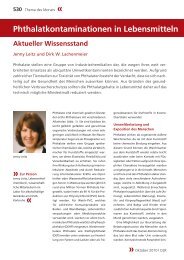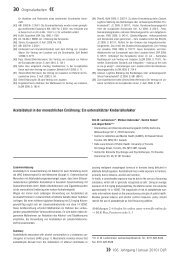Chemical composition of whiskies produced in ... - Dirk Lachenmeier
Chemical composition of whiskies produced in ... - Dirk Lachenmeier
Chemical composition of whiskies produced in ... - Dirk Lachenmeier
Create successful ePaper yourself
Turn your PDF publications into a flip-book with our unique Google optimized e-Paper software.
[7] Instrução Normativa: Instrução Normativa Nº 13 de 29 de junho de<br />
2005 do M<strong>in</strong>istério da Agricultura, Pecuária e Abastecimento do Brasil.<br />
Diário Oficial da União 124, Seção 1, pp. 3–4 (2005).<br />
[8] <strong>Lachenmeier</strong> DW et al.: Cancer risk assessment <strong>of</strong> ethyl carbamate <strong>in</strong><br />
alcoholic beverages from Brazil with special consideration to the spirits<br />
cachaça and tiquira. BMC Cancer 10, 266 (2010).<br />
[9] European Food Safety Authority: Ethyl carbamate and hydrocyanic acid<br />
<strong>in</strong> food and beverages, scientific op<strong>in</strong>ion <strong>of</strong> the panel on contam<strong>in</strong>ants.<br />
EFSA J 551, 1–44 (2007).<br />
[10] Aylott RI, MacKenzie WM: Analytical strategies to confirm the generic<br />
authenticity <strong>of</strong> Scotch whisky. J Inst Brew<strong>in</strong>g 116, 215–229 (2010).<br />
[11] Nóbrega ICC et al.: Ethyl carbamate <strong>in</strong> pot still cachaças (Brazilian<br />
sugar cane spirits): Influence <strong>of</strong> distillation and storage conditions.<br />
Food Chem 117, 693–697 (2009).<br />
[12] Caldas NM et al.: Effect <strong>of</strong> modifiers for As, Cu and Pb determ<strong>in</strong>ation <strong>in</strong><br />
sugar-cane spirits by CG AAS. Food Chem 113, 1266-1271 (2009).<br />
Proben von Bedarfsgegenständen – risikoorientiert geplant<br />
E<strong>in</strong> Vorschlag der amtlichen Überwachung <strong>in</strong> Ostwestfalen-Lippe (OWL)<br />
Zusammenfassung<br />
Im Jahr 2007 haben Sachverständige der Überwachungsbehörden und<br />
der Untersuchungse<strong>in</strong>richtung <strong>in</strong> Ostwestfalen-Lippe (OWL) geme<strong>in</strong>sam<br />
e<strong>in</strong> fachliches Konzept zur risikoorientierten Ermittlung der Probenzahlen<br />
im Rahmen der Lebensmittelüberwachung vorgelegt, im Jahr<br />
2009 folgte e<strong>in</strong>e Ergänzung für den Bereich der Überwachung kosmetischer<br />
Mittel. Bedarfsgegenstände waren bisher noch ausgeklammert.<br />
Hiermit wird nun e<strong>in</strong> ergänzendes Konzept mit e<strong>in</strong>er spezifischen Berechnungsgrundlage<br />
für den Bereich der Bedarfsgegenstände vorgestellt.<br />
Zentrale Elemente s<strong>in</strong>d die E<strong>in</strong>teilung der Bedarfsgegenstände <strong>in</strong><br />
drei Risikogruppen sowie die Zuordnung von Herstellern und Importeuren<br />
e<strong>in</strong>er bestimmten Region zu den verschiedenen Arten von Bedarfsgegenständen<br />
(Wirtschaftsstrukturdaten).<br />
Die jeweiligen Probenzahlen pro Jahr für e<strong>in</strong>e bestimmte Produktgruppe<br />
können aus vorhandenen Daten über die Anzahl der herstellenden oder<br />
importierenden Unternehmen mit Hilfe e<strong>in</strong>es Produktrisik<strong>of</strong>aktors und unter<br />
Berücksichtigung e<strong>in</strong>es def<strong>in</strong>ierten Probensolls berechnet werden. Wie<br />
schon <strong>in</strong> den vorangegangenen Konzepten für Lebensmittel und kosmetische<br />
Mittel liegt das Hauptaugenmerk auf Herstellern und Importeuren.<br />
Soweit möglich, berücksichtigt das Konzept neben dem Gesundheitsschutz<br />
auch den Aspekt des Täuschungsschutzes. Wie schon zuvor für<br />
kosmetische Mittel wird auch hier schließlich der vorgegebene Proben-<br />
DLR | März 2013 | 109. Jahrgang «<br />
» Orig<strong>in</strong>alarbeiten 149<br />
[13] European Commission: Commission Regulation (EC) No 2870/2000<br />
lay<strong>in</strong>g down Community reference methods for the analysis <strong>of</strong> spirits<br />
dr<strong>in</strong>ks. Off J Eur Union L 333, 20 (2000).<br />
[14] <strong>Lachenmeier</strong> DW et al.: Quantification <strong>of</strong> selected volatile constituents<br />
and anions <strong>in</strong> Mexican Agave spirits (Tequila, Mezcal, Sotol, Bacanora).<br />
J Agric Food Chem 54, 3911–3915 (2006).<br />
[15] Aylott RI et al.: Ethyl carbamate formation <strong>in</strong> gra<strong>in</strong> based spirits. Part I:<br />
Post-distillation ethyl carbamate formation <strong>in</strong> matur<strong>in</strong>g gra<strong>in</strong> whisky.<br />
J Inst Brew<strong>in</strong>g 96, 213–221 (1990).<br />
[16] MacKenzie WN, Clyne AH, MacDonald LS: Ethyl carbamate formation<br />
<strong>in</strong> gra<strong>in</strong> based spirits. Part II: The identification and determ<strong>in</strong>ation<br />
<strong>of</strong> cyanide related species <strong>in</strong>volved <strong>in</strong> ethyl carbamate formation <strong>in</strong><br />
Scotch gra<strong>in</strong> whisky. J Inst Brew<strong>in</strong>g 96, 223–232 (1990).<br />
[17] Cook R et al.: Ethyl carbamate formation <strong>in</strong> gra<strong>in</strong> based spirits. Part III:<br />
The primary source. J Inst Brew<strong>in</strong>g 96, 233–244 (1990).<br />
Annette Neuhaus1# , Claudia B<strong>in</strong>dl2 , Helma Haffke3 und Thomas Stuke4 1 Kreis Lippe, Veter<strong>in</strong>ärangelegenheiten und Lebensmittelüberwachung,<br />
Felix-Fechenbach-Str. 5, 32756 Detmold<br />
2 Kreis Höxter, Veter<strong>in</strong>ärdienst und Lebensmittelüberwachung,<br />
37669 Höxter<br />
3 Chemisches und Veter<strong>in</strong>äruntersuchungsamt Ostwestfalen-Lippe,<br />
32717 Detmold<br />
4 Kreis Herford, Veter<strong>in</strong>är- und Lebensmittelüberwachung,<br />
32045 Herford<br />
zahlrahmen, wie er sich aus der AVV RÜb ergibt, kritisch h<strong>in</strong>terfragt.<br />
Dieser Beitrag stellt darüber h<strong>in</strong>aus e<strong>in</strong> Schema mit Kriterien zur <strong>in</strong>dividuellen<br />
Beurteilung der Eigenkontrollsysteme vor.<br />
Summary<br />
In 2007 experts <strong>of</strong> competent authorities and laboratory <strong>in</strong> Ostwestfalen-<br />
Lippe (OWL) have mutually <strong>of</strong>fered a specialist concept <strong>of</strong> a risk based<br />
sampl<strong>in</strong>g system for the performance <strong>of</strong> <strong>of</strong>ficial food control. Cosmetic<br />
products and commodities were still excluded. In 2009 followed a correspond<strong>in</strong>g<br />
concept for cosmetic products. Hereby a supplementary suggestion<br />
is presented with a specific basis for the estimation <strong>of</strong> samples<br />
<strong>of</strong> commodities <strong>in</strong>clud<strong>in</strong>g food contact materials.<br />
Central elements are the division <strong>of</strong> commodities <strong>in</strong>to three risk groups<br />
as well as a data <strong>of</strong> the economic structure <strong>of</strong> a local region, for example<br />
the service area <strong>of</strong> a laboratory. The respective sampl<strong>in</strong>g number/<br />
year for one special group <strong>of</strong> products can be calculated with the knowledge<br />
<strong>of</strong> the number <strong>of</strong> bus<strong>in</strong>ess operators, who produce or import these<br />
k<strong>in</strong>ds <strong>of</strong> commodities and with a factor for the risk assessment <strong>of</strong> the<br />
# Annette Neuhaus; Tel.: 05231/62-231; a.neuhaus@kreis-lippe.de





